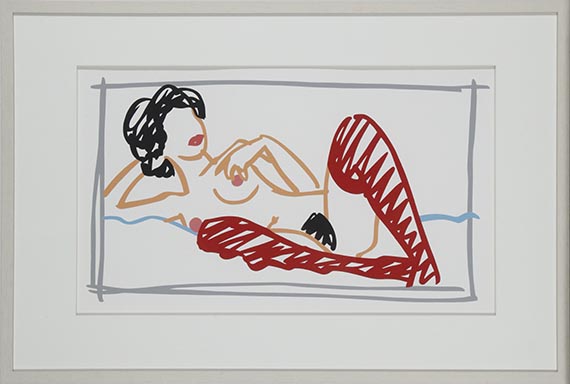23
Tom Wesselmann
Fast Sketch Red Stocking Nude, 1991.
Silkscreen in colors
Starting bid: € 4,500 / $ 5,310
Fast Sketch Red Stocking Nude. 1991.
Silkscreen in colors.
Signed and numbered. On firm cardboard. 46 x 82 cm (18.1 x 32.2 in). Sheet: 66 x 98 cm (25,9 x 38,5 in).
From an edition of 100 copies. Printed by Steve Maiorano, Screened Images, New York, and published by International Images, Vermont (each with dry stamp). [KA].
• An intimate portrait in vibrant colors in Tom Wesselmann's unmistakable style.
• Tom Wesselmann is one of the most renowned artists of contemporary pop art.
• Nudes by Wesselmann are included in numerous international collections, such as the Museum of Modern Art, New York, the Whitney Museum of American Art, New York, and Tate Modern, London.
• Most recently, the Fondation Louis Vuitton in Paris presented the exhibition “Pop Forever: Tom Wesselmann &..,” which was met with great public acclaim.
PROVENANCE: Private collection, North Germany (since ca. 2008).
LITERATURE: The Wildenstein Plattner Institute / Tom Wesselmann Estate (eds.), The Tom Wesselmann Digital Corpus, online catalogue raisonné no. "TWEN0Q".
In good condition.
Silkscreen in colors.
Signed and numbered. On firm cardboard. 46 x 82 cm (18.1 x 32.2 in). Sheet: 66 x 98 cm (25,9 x 38,5 in).
From an edition of 100 copies. Printed by Steve Maiorano, Screened Images, New York, and published by International Images, Vermont (each with dry stamp). [KA].
• An intimate portrait in vibrant colors in Tom Wesselmann's unmistakable style.
• Tom Wesselmann is one of the most renowned artists of contemporary pop art.
• Nudes by Wesselmann are included in numerous international collections, such as the Museum of Modern Art, New York, the Whitney Museum of American Art, New York, and Tate Modern, London.
• Most recently, the Fondation Louis Vuitton in Paris presented the exhibition “Pop Forever: Tom Wesselmann &..,” which was met with great public acclaim.
PROVENANCE: Private collection, North Germany (since ca. 2008).
LITERATURE: The Wildenstein Plattner Institute / Tom Wesselmann Estate (eds.), The Tom Wesselmann Digital Corpus, online catalogue raisonné no. "TWEN0Q".
In good condition.
23
Tom Wesselmann
Fast Sketch Red Stocking Nude, 1991.
Silkscreen in colors
Starting bid: € 4,500 / $ 5,310
Headquarters
Joseph-Wild-Str. 18
81829 Munich
Phone: +49 89 55 244-0
Fax: +49 89 55 244-177
info@kettererkunst.de
Louisa von Saucken / Undine Schleifer
Holstenwall 5
20355 Hamburg
Phone: +49 40 37 49 61-0
Fax: +49 40 37 49 61-66
infohamburg@kettererkunst.de
Dr. Simone Wiechers / Nane Schlage
Fasanenstr. 70
10719 Berlin
Phone: +49 30 88 67 53-63
Fax: +49 30 88 67 56-43
infoberlin@kettererkunst.de
Cordula Lichtenberg
Gertrudenstraße 24-28
50667 Cologne
Phone: +49 221 510 908-15
infokoeln@kettererkunst.de
Hessen
Rhineland-Palatinate
Miriam Heß
Phone: +49 62 21 58 80-038
Fax: +49 62 21 58 80-595
infoheidelberg@kettererkunst.de
We will inform you in time.




 Lot 23
Lot 23 

